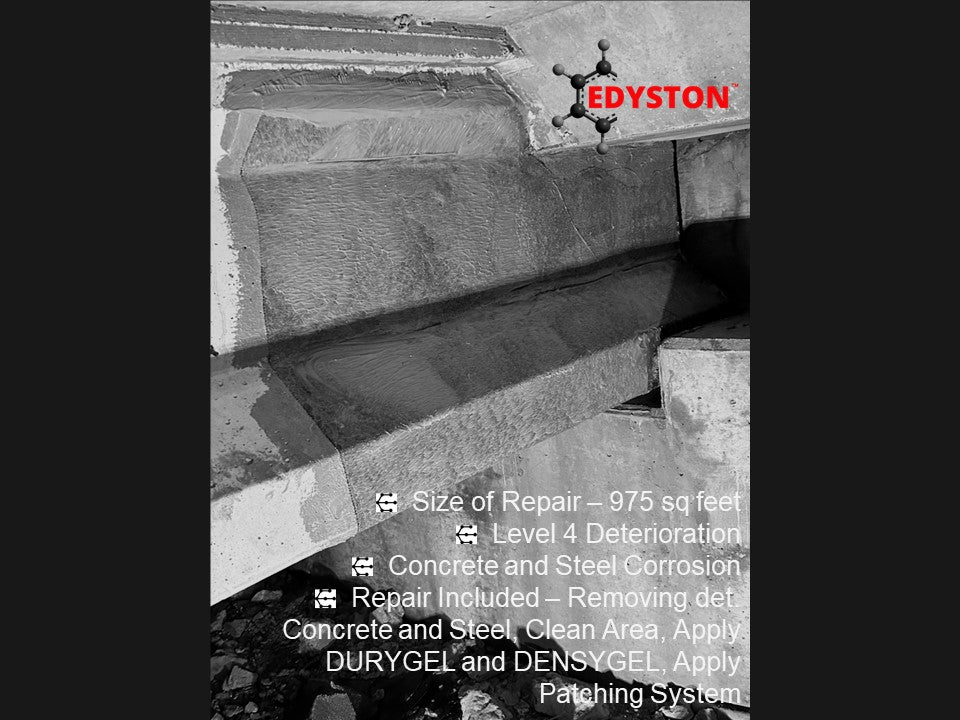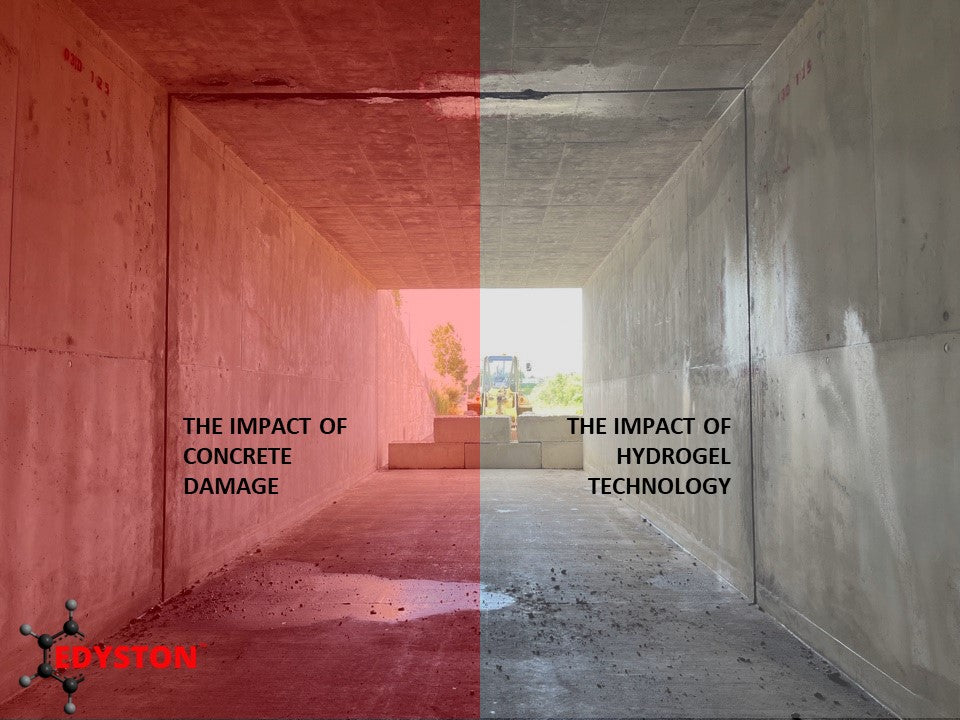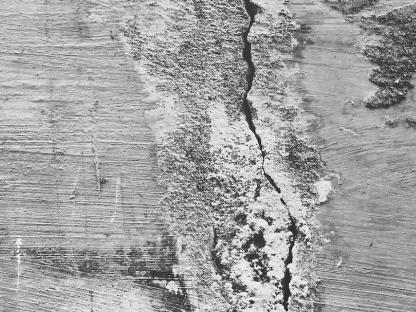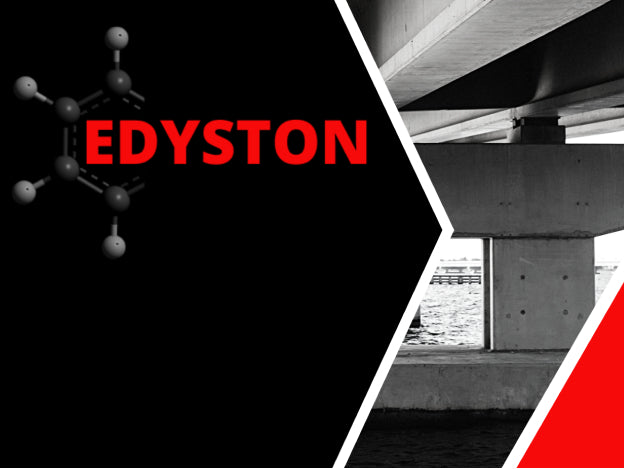Case Studies
Jones Pass Case Study
Background
EDYSTON was utilized by the Denver Waterboard to rejuvenate the Jones Pass spillway in Empire, Colorado. The project will be a mutli-year study on the impact of the EDYSTON technologies in controlling the wicking action of concrete cracks at Jones Pass. The water reclamation spillway diverts water at Jones pass and had significant damage due underwater abrasion and alkali silica reactivity, Figure 1 and Figure 2.

EDYSTON is a dispersion of nano sized particles which consumes excess water and alkalis that reside in concrete pores and cracks and produces a denser concrete. Concrete is a hardened sponge with channels that allows water to leach through the body of the concrete to the concrete surface while also allowing deleterious chemicals to flow into the concrete. EDYSTON is a spray on technology which creates a more homogenous and stable concrete structure that is less prone to excessive degradation from chemical and physical attack. When EDYSTON is added, a reaction occurs that chemically binds the concrete pore water solution. In doing so, this converts the pore solution into a bridging technology that spans the crack and pores that would cause further concrete deterioration. Furthermore, this technology in combination with the pore water solution develops into calcium silicate hydrate (“C-S-H”). C-S-H is the backbone of concrete strength and therefore, concrete enhanced with EDYSTON is denser and less permeable. This results in the decrease of water and alkalis to the surface as well as the decrease in harmful chemicals that are able to leach from the surface into the body of the concrete.
EDYSTON Application
The EDYSTON team led by Eric Tryell, began prepping the jobsite on Tuesday, August 22nd. The concrete sections were pressure washed to clean off impurities and create a saturated surface-dry (SSD) conditions. The concrete was tested for water absorption before the EDYSTON hydrogel was applied. Each section to be tested was permanently marked and photographed to create a profile of the area for extended evaluation (2-years). The markings for each are defined below, Figure 3:
- Red – REFERENCE
- White – DENSYGEL
- Blue – ENVYROGEL / DENSYGEL

Figure 3 – The spillway facility in Empire, Co (Left) and the interior of the water channel (Right).

Figure 4 – Rudimentary diagram of the interior structure. The walls numbered 1 and 2 were treated with EDYSTON.

Figure 5 – Areas Treated and Tested: White, No Treatment; Orange, DENSYGEL at 125 sq ft per gallon; Blue, DURYGEL at 250 sq ft per gallon and then DENSYGEL at 250 sq ft per gallon.
The hydrogel technology was placed in 2- to 4-sections of the concrete utilizing the method described:
- SSD the Surface of Cleaned Concrete
- Spray with clean water and allow to get to SSD before applying EDYSTON.
- Apply EDYSTON when concrete reaches SSD
- Applications until SSD is reached – use water droplet test method – ASTM E 3191.
- Less than 1 min to absorb water, Not SSD
- Greater than 1 min to absorb water, SSD
- Apply EDYSTON no more than 10-min after the SSD has been reached
- Do not allow surface to dry between coats
- Allow 5- to 10-min between coats
- Apply coats of 500-1000 sq ft per gallon
- Use sprayers: 100 to 300 psi.
373 square feet were treated with DENSYGEL and 44.5 square feet were treated with ENVRYOGEL. The sections will be retested and monitored for profile change at 1-, 180-, 365-days; 1.5-, 2-, 2.5-, and 3-years for water absorption (RILEM-Water Test), water sorptivity and ASTM C 1585 (when coring is permitted).
Results
After three and a half hours, RILEM testing was performed on the treated and untreated areas. The area treated with DENSYGEL lost 0.5 milliliter of distilled water and the untreated area lost 3.5 milliliters of distilled water, Figure 6.

Figure 6 – Water Loss for Untreated REFERENCE area versus area sprayed with DENSYGEL
These initial results indicate that the DENSYGEL hydrogel controls the wicking action of water and can be used to slow future deterioration of cracks within the concrete of the spillway. The combined data from the laboratory trials and the field trials will be used to create a cost- and service-life analysis to present value-added performance of the hydrogel technology.
Future Work
The EDYSTON project at Jones Pass spillway in Empire, Colorado was a great success. Wicking action of concrete cracks has been effectively controlled by utilizing the special technology and materials of this system. The Denver Waterboard should consider maintaining and monitoring the site for wicking action over time to assess its ongoing performance. It's also important to recognize that similar initiatives can be taken by other areas in need of water spillway rejuvenation, as EDYSTON proved itself both cost effective and efficient at Jones Pass. With continuing research into this innovative technology, more sites around the world could benefit from its unique benefits.






